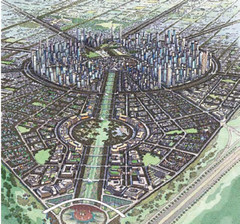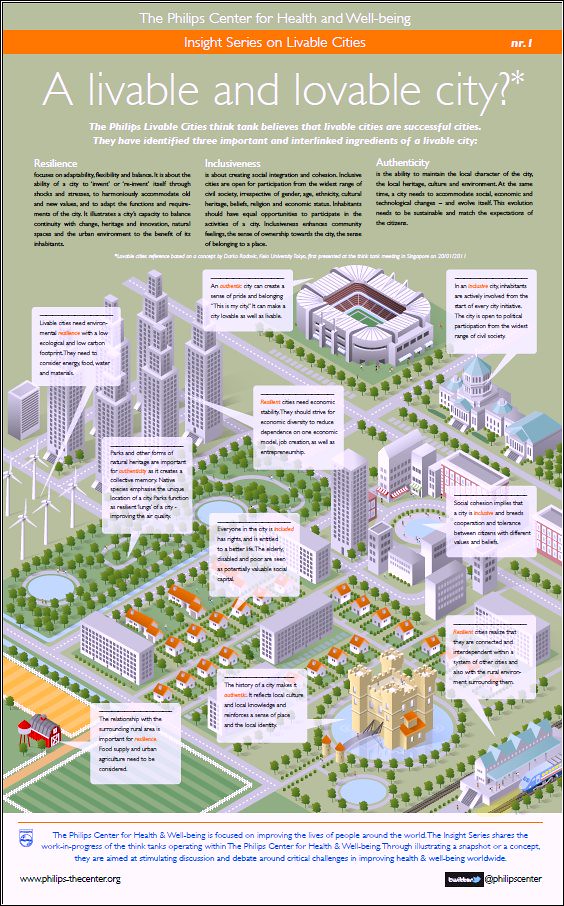Resource: making cities "livable and lovable"

Posted April 21, 2011 at 1:34PM
I haven’t spent nearly as much time as I hope to with the resources on the web site of the Philips Center for Health and Well-Being, but it has caught my eye, particularly for the attention paid there to “livable cities.” The Center’s perspective is international and intellectual, and includes a “multi-disciplinary panel of think tank experts.”
Here’s one of those experts, Olivier Piccolin, a senior vice president in charge of Philips’s commercial lighting division:
“Today, new factors demand we urgently change our view of cities and how they should evolve. First, the urban growth surge, spawning mega-cities in Asia and other emerging economies, is unlike anything experienced in history. Secondly, the ecological imperative of reducing urban consumption of carbon and other resources forces us to find accelerated solutions.
And there’s intense pressure on budgets to support the increasing demand for public services in cities, So we must find new definitions of what makes a successful city.
“The Center’s Livable Cities think tank has begun the task of defining how a fit-for-the- future city can be created and sustained, in emerging markets. So ‘success’ will not be judged solely in terms of economic growth and efficiency, but will include more subjective factors including social, economic and environmental resilience, and inclusiveness for all parts of the population and diversity – as well as remaining authentic during transition. Perhaps ‘equal opportunity’ or ‘percentage of green spaces’ will one day sit alongside GDP as a component in future rankings of successful cities.”
The goal of the think tank is to develop and present extensive findings for presentation to mayors of the world’s largest cities next year.
I’m on record as saying that we need to be cautious about placing blind faith in high-tech panaceas for cities that come from corporations with a large financial stake in the adoption of high-tech solutions. But this particular initiative is not so easily caricatured, and appears to deserve to be taken seriously.
I am particularly struck by a graphic that captures key elements of urban sustainability in a nicely informative way:
Click on the image to see a larger, more readable version.
I like the three major themes of resilience, inclusiveness, and authenticity, captured in various ways in the illustration. Authenticity in particular is insufficiently discussed in the circles I inhabit.
There is also a 28-page report, Livable cities in a rapidly urbanizing world, sponsored by Philips and developed by the International Society of City and Regional Planners. Fascinating to browse, the report includes case studies from (among other places) Singapore, Seoul, New York, the US Gulf Coast (quoting Dhiru Thadani),  Portland, the Netherlands, and Los Angeles. There is a bit of an emphasis on Asia and the Pacific and very little on Africa or South America (but for Curatiba), but I was impressed that the discussion caught such details as problems associated with New York City’s Cross-Bronx Expressway and solutions highlighted in Portland’s “20-minute neighborhoods.”
Portland, the Netherlands, and Los Angeles. There is a bit of an emphasis on Asia and the Pacific and very little on Africa or South America (but for Curatiba), but I was impressed that the discussion caught such details as problems associated with New York City’s Cross-Bronx Expressway and solutions highlighted in Portland’s “20-minute neighborhoods.”
I was also impressed to see the report push the definition of “cities” beyond our conventional frames of reference, something I have touched on in a different way and context. It also stresses the importance of regional governance, mixed land uses, and the arts. In a number of ways, the report – and other materials on the web site – appears to avoid the easy answers and, instead, pose the hard questions. I look forward to learning more.
Move your cursor over the images for credit information.
